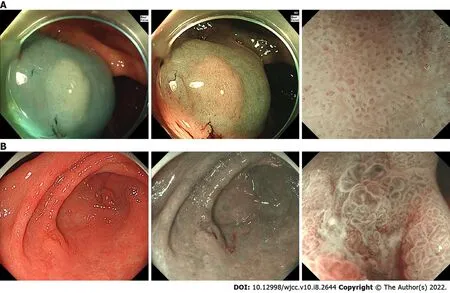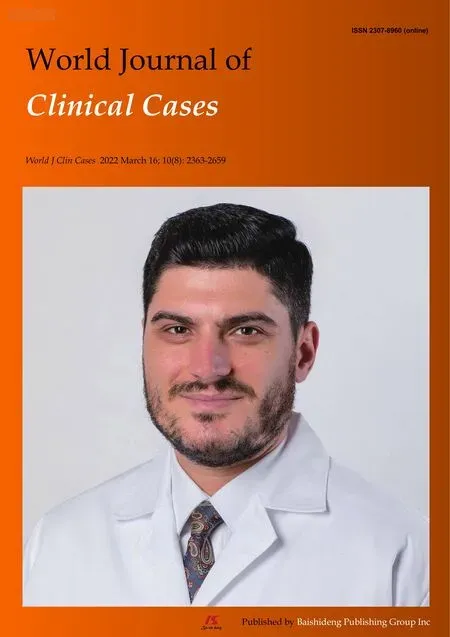Synchronized early gastric cancer occurred in a patient with serrated polyposis syndrome:A case report
INTRODUCTION
Serrated polyposis syndrome(SPS),previously known as hyperplastic polyposis,is a relatively rare disease that is characterized by multiple serrated lesions/polyps(SL/Ps),mainly in the proximal colon[1].An increasing body of evidence suggests that patients with SPS have an increased risk of colorectal cancer(CRC)but the genetic basis of the process remains unknown[2].Also,very little is known regarding the extracolonic cancers associated with SPS.To understand the molecular basis of SPS,it is important to identify the corresponding disease-causing genes.Because whole-exome sequencing can almost cover the entirety of protein-coding regions in the genome,which contains approximately 85% of disease-relevant mutations,it can serve as a powerful tool for cost-effective disease mechanistic research[3].
This paper reports a patient with SPS and synchronized early gastric cancer(GC)treated with endoscopic submucosal dissection(ESD),along with some potential causative mutations found in exome sequencing.
CASE PRESENTATION
Chief complaints
A 67-year-old male patient initially presented with belching and abdominal distension for a year as well as diarrhea for over 2 mo.
History of present illness
The patient had no history of present symptoms.
History of past illness
The patient had a history of hypertension that was well controlled with medication.
Personal and family history
Since the patient wasnegative,the diagnosis ofinfection-related GC was excluded.
Physical examination
The authors have read the CARE Checklist(2016),and the manuscript was prepared and revised according to the CARE Checklist(2016).
Laboratory examinations
No personal or family history of SPS or cancers was reported.
Imaging examinations
Christmas is a season of giving, I told my students. There are a few students in the school who might not have a happy holiday season. By contributing to our Christmas collection, you will help buy food, clothing and toys for these needy4 people. We start the collection tomorrow.

Methods of genetic analysis
Total genome DNA from peripheral blood was extracted using the cetrimonium bromide/sodium dodecyl sulfate method.Gene libraries were constructed and paired-end sequencing was performed using the IlluminaHiSeq platform.Statistics was mapped with a reference genome using Burrows-Wheeler Alignment software(parameters: mem-t4-k32-M)and the duplicates were removed by Picard.Individual single nucleotide polymorphism(SNP)variations were detected using the Genome Analysis Toolkit.Subsequently,annotation of the detected SNPs was performed using SnpEff.
Results of genetic analyses
To explore the molecular characteristics of the patient,sequencing analysis was performed.Exome sequencing identified 3111 nonsynonymous single nucleotide variants in the exon region.These genes were filtered by the mutation data in ClinVar,COSMIC v90 and previous genome-wide association study reports.Five GC-associated variants(methylenetetrahydrofolate reductase[MTHFR],metaxin 1[MTX1],coiled-coil domain containing 6[CCDC6],glutamate ionotropic receptor delta type subunit 1[GRID1],and aldehyde dehydrogenase 1[ALDH2])were identified,as shown in Table 1.Additionally,a cross check for genes that has been reported as causative of SPS or relating to the serrated pathway was performed.The BRAF V600E and KRAS G12D mutations,common hotspot mutations in SPS,were not found.

FINAL DIAGNOSIS
The pathological result of the lesion in the gastric antrum was high-grade dysplasia with focal intramucosal carcinoma.
TREATMENT
Curativeresection of the lesion was achievedendoscopic submucosal dissection(ESD).
The next day the wedding took place, and the two brothers came to the house, and they all lived happily together, but they never forgot the holy man who had been such a good friend
Written informed consent was obtained from the patient.
OUTCOME AND FOLLOW-UP
The lesion in gastric antrum was considered to be curatively resected.No recurrence was observed on her last esophagogastroduodenoscopy surveillance 1 year after surgery.
DISCUSSION
SL/Ps include hyperplastic polyps,traditional serrated adenoma,and SSLs.SPS was redefined by World Health Organization(WHO)in 2019 and its diagnosis is based on the cumulative number of serrated lesions in a patient who meets one of the two following WHO criteria: ≥ 5 SL/Ps proximal to the rectum,all ≥ 5 mm in size and including ≥ 2 Larger than 10 mm;or >20 SL/Ps of any size distributed throughout the colon,with ≥ 5 proximal to the rectum[1].The true prevalence of SPS is likely under-recognized and not diagnosed because of the need to keep track of the cumulative lifetime number of SL/Ps in a patient[4].To monitor for risk of malignant progression,endoscopic surveillance is recommended for all patients every 1 year to 3 years[5];however,suitable monitoring schedules remain controversial.
This had kept their hands very soft and white, like the hands of a girl, and when the water was passed through the lattice, and the servant saw the small, delicate fingers, he said to himself: A maiden must indeed be lovely if she has a hand like that
SL/Ps are currently recognized as the precursors of CRC and SPS has been considered a high-risk condition for CRC.However,there are only a few reported cases of SPS patients having extracolonic malignancies and the association between SPS and extracolonic cancer risk in various studies are not consistent.In their American cohort,Jasperson[6]found 12 of 51 SPS patients(24%)had a history of extracolonic tumors,but none were found to have gastric lesions.Hazewinkel[7]reported 9 of 105 SPS patients(8.6%)from five medical centers in Europe,which did not significantly differ from the expected number of the general population,but the cancer-specific risk was not estimated.A Korean study[8]reported the diagnosis of stomach cancer in 2 of 30 SPS patients(6.7%)esophagogastroduodenoscopy,suggesting that Asian patients with SPS require screening of the upper gastrointestinal tract.The lack of data makes it difficult to determine whether patients with SPS are at increased risk of extracolonic cancers or whether these tumors were unrelated to SPS.
In the present case,the stomach lesion was detected in the postoperative re-examination 6 mo after the diagnosis of SPS.As gastroscopy was not performed when the sessile serrated lesions were removed from the colon,the condition of any GC at that time cannot be confirmed.This emphasizes the importance of upper gastrointestinal tract screening in SPS patients.
To date,some molecular signatures of the serrated pathway of CRC formation have been described,including BRAF and KRAS mutations,microsatellite instability and CpG island methylator phenotype.However,the molecular processes of tumorigenesis are still largely unknown,let alone the molecular characteristics of synchronized cancers.Having sequenced the exosome of the patient’s peripheral blood,five variants(MTHFR,MTX1,CCDC6,GRID1,and ALDH2),which are reportedly related to GC,were identified.MTHFR encodes a key enzyme in the folate metabolism pathway,with MTHFR polymorphisms having a functional impact on metabolism[9].ALDH2,encoding tissue alcohol metabolizing enzymes,can influence acetaldehyde levels in the stomach,which increase the risk of GC through a variety of mechanisms[10].MTX1 encodes metaxin-1,a mitochondrial protein involved in tumor necrosis factor-induced cell death[11].MTX1 is overexpressed in GC tissue compared with paired normal tissues,and patients with higher MTX1 expression experience a poorer prognosis[12].CCDC6,which is recognized as the target gene of microRNA-149-5p(miR-149-5p)and miR-19b-3p[13],inhibits cell proliferation and the epithelial-mesenchymal transition and facilitates cell apoptosis[14].Although the glutamate receptor GRID1 exclusively functions in the central nervous system,recent evidence suggests that GRID1 may also be involved in multiple kinds of malignant processes during the progression of cancer[15].As the annotation information of SPS-related genes is limited,we could only first identify the mutations that are reportedly closely related to GC.Considering the characteristics of this patient,these five mutations are presumably associated with both GC and SPS.The mechanism by which these genes affect the pathogenesis of GC and SPS remains to be determined.
“Steer, Mom! Straighten it out!” I yelled. Mom didn’t seem to hear me. She and the bike turned left, went off the sidewalk, and rolled into a little green bush. Then slowly Mom and the bike fell over.
The authors declare that they have no conflicts of interest.
CONCLUSION
In conclusion,this paper reports a case that presented with both SPS and early GC.Genetic mutations that were potentially responsible for this condition were identified by exome sequencing.Further studies are needed regarding the extracolonic cancer risk of SPS patients.
FOOTNOTES
Ning YZ wrote the manuscript;Liu GY and Rao XL collected the data;Ma YC analyzed the data;Rong L designed the research study;all authors have read and approved the final manuscript.
26.May not be idle: The Devil finds work for idle hands is a proverb that appeared in print in English in the early 18th century. Return to place in story.
Two can play at that game, I responded. I will wear my gray suit, my Borsalino imported straw hat and a new silk tie. We will be dressed to the nines. This town will never be the same. Almost like our first date.
Here,exome sequencing was performed for a patient with SPS and synchronized early GC.Although a single patient is not sufficient to identify potential genetic characteristics of SPS,the findings still add to the body of knowledge on the molecular mechanism underpinning SPS with synchronized GC.Further validation experiments using resected specimen are necessary to clarify the effect of mutations on GC and SPS.
Physical examination was unremarkable.
The patient underwent colonoscopy and found multiple flat and sessile polyps located throughout different segments of the colon and ranging from 5 to 20 mm in diameter.More than 10 polyps were removed and pathological examination confirmed most polyps to be sessile serrated lesions(SSLs)and 4 as tubular adenoma,all without severe dysplasia(Figure 1A).The diagnosis of SPS was established.Half a year later,a gastroscopy was performed during the postoperative re-examination to screen for other lesions of the upper gastrointestinal tract.An elevated lesion was detected in the anterior wall of the gastric antrum(Figure 1B).
This article is an open-access article that was selected by an in-house editor and fully peer-reviewed by external reviewers.It is distributed in accordance with the Creative Commons Attribution NonCommercial(CC BYNC 4.0)license,which permits others to distribute,remix,adapt,build upon this work non-commercially,and license their derivative works on different terms,provided the original work is properly cited and the use is noncommercial.See: https://creativecommons.org/Licenses/by-nc/4.0/
China
Then the King was full of joy, and when he saw the Queen coming, he hid Trusty John and the two children in a big cupboard. As she entered he said to her: Did you pray in church? Yes, she answered, but my thoughts dwelt constantly on Trusty John, and of what he has suffered for us. Then he spake: Dear wife, we can restore him to life, but the price asked is our two little sons; we must sacrifice them. The Queen grew white and her heart sank, but she replied: We owe it to him on account of his great fidelity. Then he rejoiced that she was of the same mind as he had been, and going forward he opened the cupboard, and fetched the two children and Trusty John out, saying: God be praised! Trusty John is free once more, and we have our two small sons again. Then he related to her all that had passed, and they lived together happily ever afterward47.
Ying-Ze Ning 0000-0002-7164-2698;Guan-yi Liu 0000-0002-4663-5277;Xiao-Long Rao 0000-0002-9277-7524;Yong-chen Ma 0000-0003-3047-3688;Long Rong 0000-0002-3635-4682.
Ma YJ
Filipodia
In late August, Karen walked down the aisle with a handsome father on each side of her. They wore identical tuxedos10 with matching smiles and radiated the same fatherly love and joy.
Ma YJ
 World Journal of Clinical Cases2022年8期
World Journal of Clinical Cases2022年8期
- World Journal of Clinical Cases的其它文章
- eHealth,telehealth,and telemedicine in the management of the COVID-19 pandemic and beyond:Lessons learned and future perspectives
- COVID-19 pandemic and nurse teaching:Our experience
- Large cystic-solid pulmonary hamartoma:A case report
- Drain-site hernia after laparoscopic rectal resection:A case report and review of literature
- Cystic teratoma of the parotid gland:A case report
- Silver dressing in the management of an infant's urachal anomaly infected with methicillin-resistant Staphylococcus aureus:A case report
